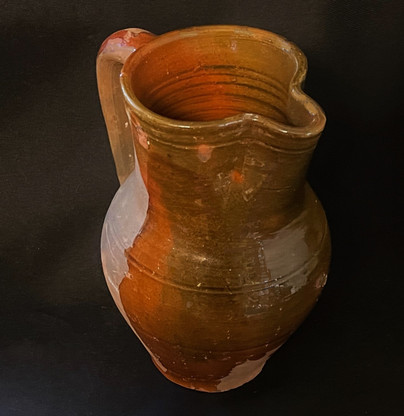 Loading... Please wait...
Loading... Please wait...-
Call us on (973) 810-2976
- My Account
- Gift Certificates
- Items / $0.00
All prices are in All prices are in USD
Categories
- Home
- Identified Artifacts
- 18th century redware pitcher, as in Williamsburg Museum
- Home
- Non-excavated Artifacts
- 18th century redware pitcher, as in Williamsburg Museum
- Home
- Personal Items
- 18th century redware pitcher, as in Williamsburg Museum
- Home
- Late 18th Century / Early 19th Century
- 18th century redware pitcher, as in Williamsburg Museum
- Home
- Revolutionary War items
- 18th century redware pitcher, as in Williamsburg Museum
18th century redware pitcher, as in Williamsburg Museum
Product Description
Being offered is a lead-glazed red earthenware pitcher, circa 1785 - 1795. The overall height is 9 ¾”, 4” wide at the top, 6” in the center and 3” diameter base. It has an inconsistent shine which was common with some redware because of the firing methods.
This was utilitarian pottery which met the colonial consumer's need for inexpensive, everyday wares for food preparation, dairying, and tableware. Prior to the initiation of redware manufacture in America, a flourishing network of commercial trade throughout 17th-century Europe contributed to the ethnic fusion of specific vessel shapes. By the late 1700s, immigrant craftsmen had incorporated these specific vessel shapes into their potting repertoire.
The uneven shine often seen on 18th-century redware is attributed to several factors related to the materials and methods used in their creation. Redware was fired at relatively low temperatures, typically between 1600 and 1800 degrees Fahrenheit, in simple wood-fired kilns.
This lower firing temperature sometimes meant the clay body didn't completely vitrify (turn into a glass-like state) as much as higher-fired stoneware. The porous nature of the redware body could contribute to disparities in how the glaze was absorbed and fused to the surface. The redware was just excepted how it turned out and not refired or discarded.
In the “Colonial Williamsburg Museum”, there is a very similar pitcher as this one (see pictures). Many Revolutionary War and Colonial collectors prefer redware with the disparities of finishes, making each one unique. At many Revolutionary War sites there are shards of redware recovered.



